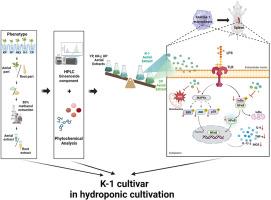水培人参新栽培品种 K-1 的茎叶:抗炎制剂中人参皂苷的可持续创新资源
IF 6.8
2区 医学
Q1 CHEMISTRY, MEDICINAL
引用次数: 0
摘要
背景韩国人参(Panax ginseng Meyer)是亚洲东部种植的一种传统药用植物,最近因其在水培栽培方面的潜在进步而备受关注,它提供了一种可持续的创新资源。此外,在典型的人参加工过程中,茎叶通常被丢弃,导致资源浪费,并忽略了其作为传统优先根茎替代品的经济价值潜力。方法最初,我们研究了五个韩国水培人参品种的表型,即Kumpoong(KP)、Chunpoong(CP)、Honkaejong(HKJ)、Yunpoong(YP)和K-1。随后,我们重点评估了空中提取物,以确定最适合可靠资源的栽培品种。结果 K-1 栽培品种表现出优异的表型特征和抗病原体能力。高效液相色谱法(HPLC)结果显示,与根提取物相比,气生提取物中的人参皂苷含量高出四倍,并表现出相当丰富的人参皂苷 Rd。K-1 的气提物显示出最高的植物化学成分含量。CP 和 K-1 的气提物在减少 ROS 生成、缓解线粒体功能障碍以及通过 NF-κB 和 MAPKs 信号通路减少促炎细胞因子(IL-6、TNF-α、iNOS)方面表现出更大的功效,这在 50 mg/kg 剂量的活体实验中得到了证实。结论我们的研究结果表明,水培人参栽培品种 K-1 的茎叶具有优越的茎叶表型和植物提取物中的植物化学成分,而且在膳食干预中具有抗炎潜力,因此是传统价值人参根的经济替代品。本文章由计算机程序翻译,如有差异,请以英文原文为准。

Stem-and-leaf of new hydroponically-cultured ginseng cultivar K-1: A sustainable and innovative resource of ginsenosides for anti-inflammatory agents
Background
Korean ginseng (Panax ginseng Meyer), a traditional medicine plant cultivated in eastern Asia, has recently captured attention for its potential advancements in hydroponic cultivation, offering a sustainable and innovative resource. Additionally, in the typical processing of ginseng, stem-and-leaf are commonly discarded, leading to resource wastage and overlooking their economically valuable potential as an alternative to the conventionally prioritized roots.
Methods
Initially, we investigated the phenotype of five Korean hydroponically cultivated ginseng cultivars, namely Kumpoong (KP), Chunpoong (CP), Honkaejong (HKJ), Yunpoong (YP), and K-1. Subsequently, we focused on evaluating aerial extracts to identify the most suitable cultivar for reliable resources. This involved phytochemical compositions and anti-inflammatory effects in LPS-stimulated RAW264.7 macrophages and LPS-induced mice, employing quantitative real-time PCR, ELISA, and western blotting.
Results
The K-1 cultivar exhibited superior phenotypic traits and pathogen resistance. HPLC results revealed that aerial extracts contained four times higher ginsenoside content and exhibited a considerable abundance of ginsenoside Rd compared to root extracts. K-1 aerial extract exhibited the highest phytochemical content. The aerial extract of CP and K-1 exhibited greater efficacy in attenuating ROS production, mitigating mitochondrial dysfunction, and reducing pro-inflammatory cytokines (IL-6, TNF-α, iNOS) through the NF-κB and MAPKs signaling pathways, which were corroborated in vivo at a 50 mg/kg dose.
Conclusions
Our findings propose the stem-and-leaf of hydroponically cultivated ginseng cultivar K-1 presents an economical alternative to the traditionally valued ginseng root, given its superior stem-and-leaf phenotype and phytochemical content in the aerial extract coupled with promising potential for anti-inflammatory agents in dietary interventions.
求助全文
通过发布文献求助,成功后即可免费获取论文全文。
去求助
来源期刊

Journal of Ginseng Research
CHEMISTRY, MEDICINAL-INTEGRATIVE & COMPLEMENTARY MEDICINE
CiteScore
11.40
自引率
9.50%
发文量
111
审稿时长
6-12 weeks
期刊介绍:
Journal of Ginseng Research (JGR) is an official, open access journal of the Korean Society of Ginseng and is the only international journal publishing scholarly reports on ginseng research in the world. The journal is a bimonthly peer-reviewed publication featuring high-quality studies related to basic, pre-clinical, and clinical researches on ginseng to reflect recent progresses in ginseng research.
JGR publishes papers, either experimental or theoretical, that advance our understanding of ginseng science, including plant sciences, biology, chemistry, pharmacology, toxicology, pharmacokinetics, veterinary medicine, biochemistry, manufacture, and clinical study of ginseng since 1976. It also includes the new paradigm of integrative research, covering alternative medicinal approaches. Article types considered for publication include review articles, original research articles, and brief reports.
JGR helps researchers to understand mechanisms for traditional efficacy of ginseng and to put their clinical evidence together. It provides balanced information on basic science and clinical applications to researchers, manufacturers, practitioners, teachers, scholars, and medical doctors.
 求助内容:
求助内容: 应助结果提醒方式:
应助结果提醒方式:


